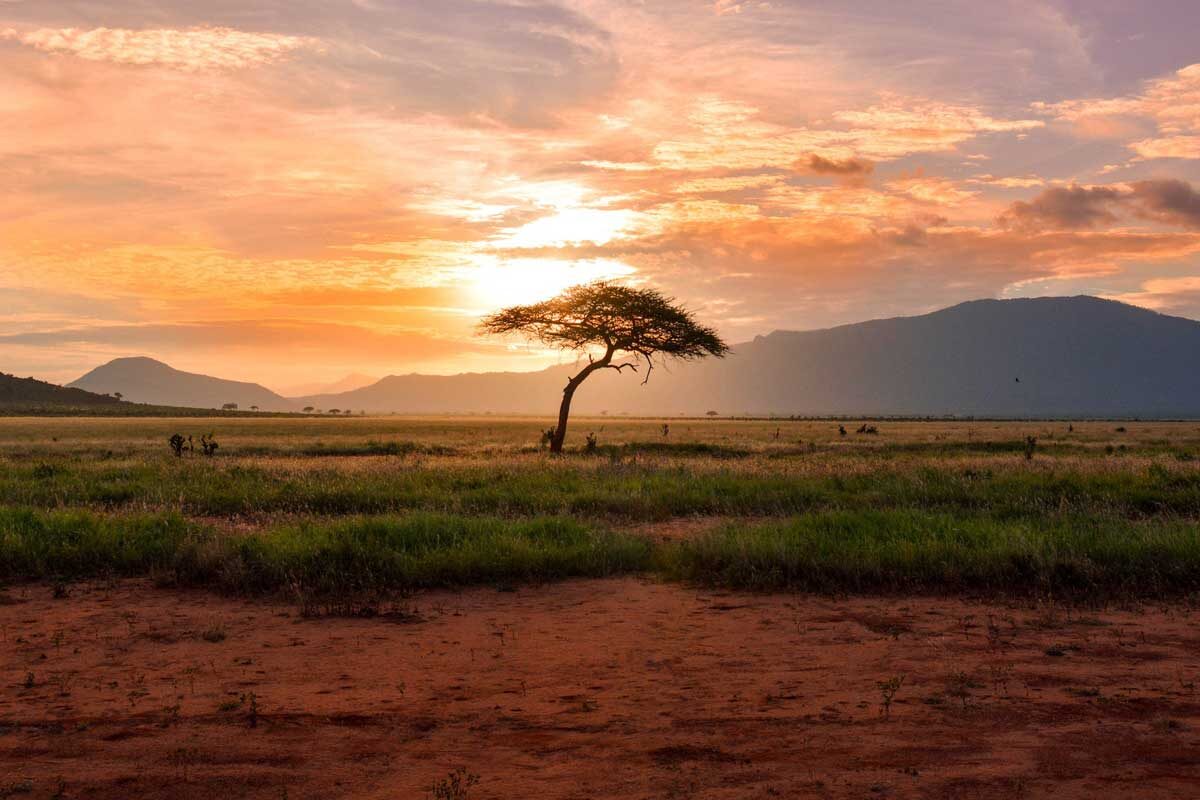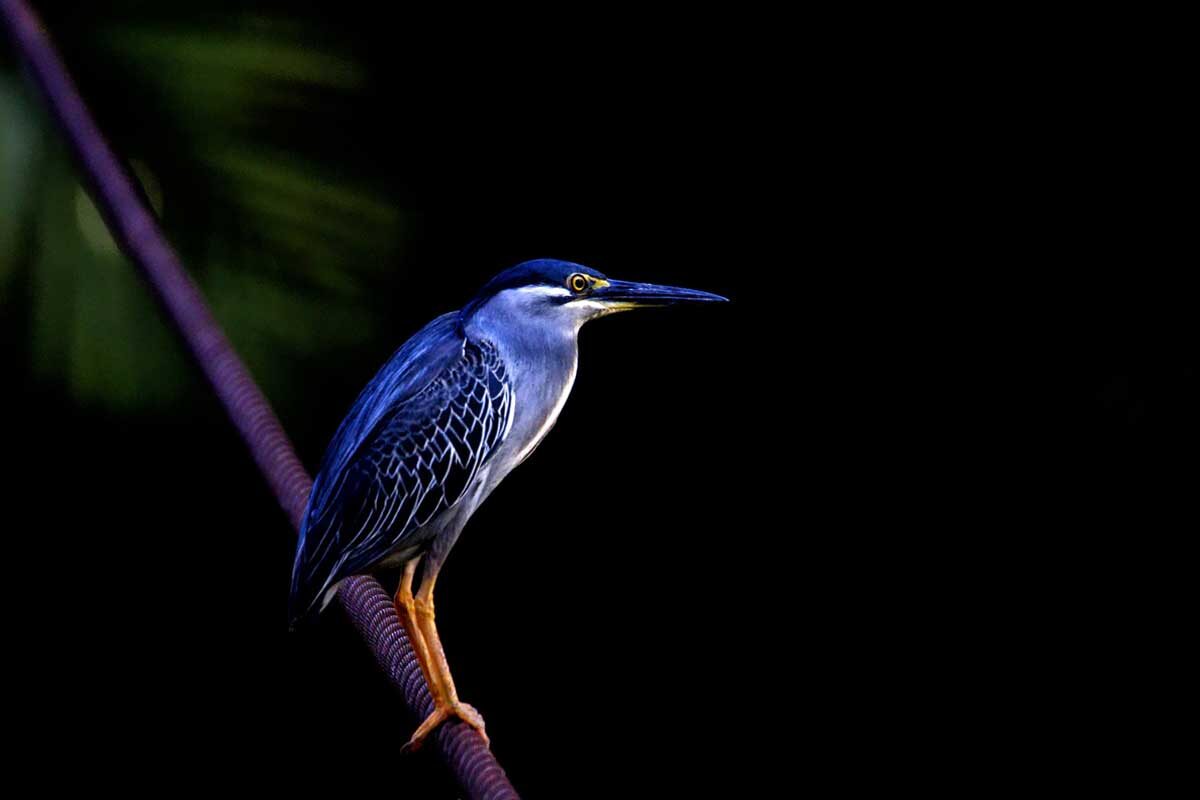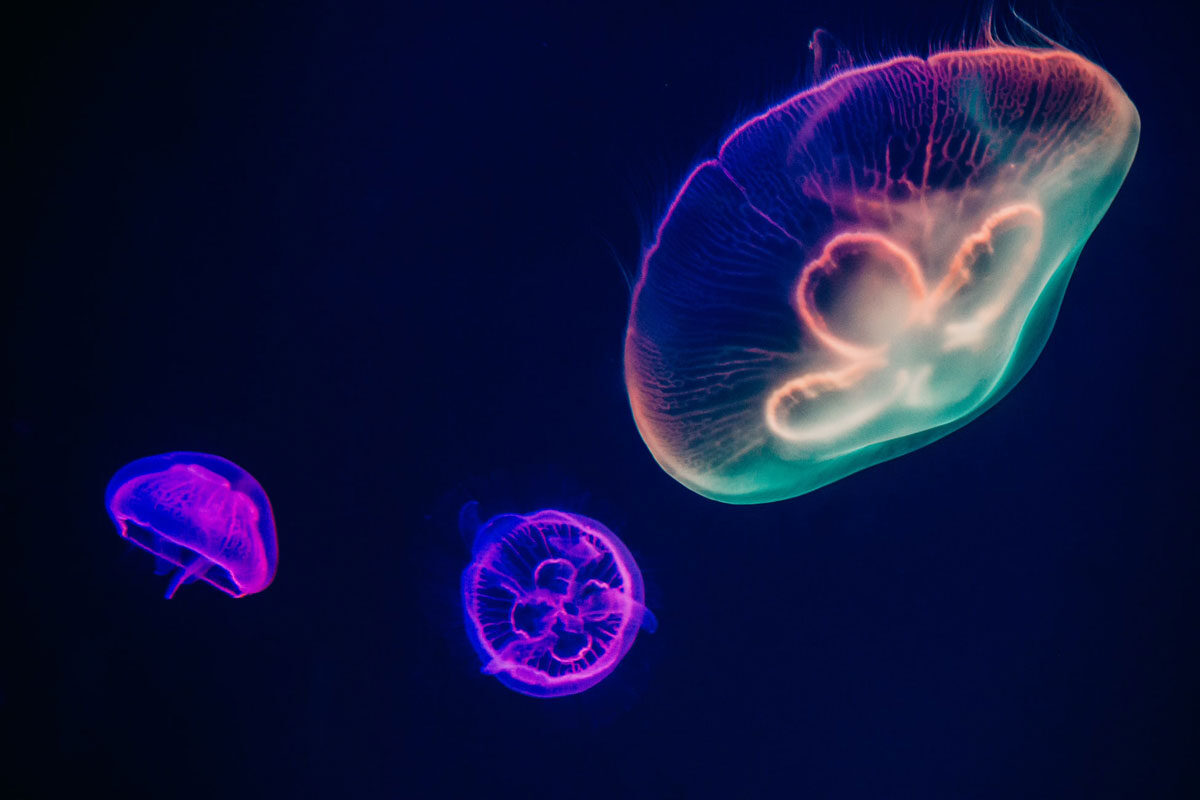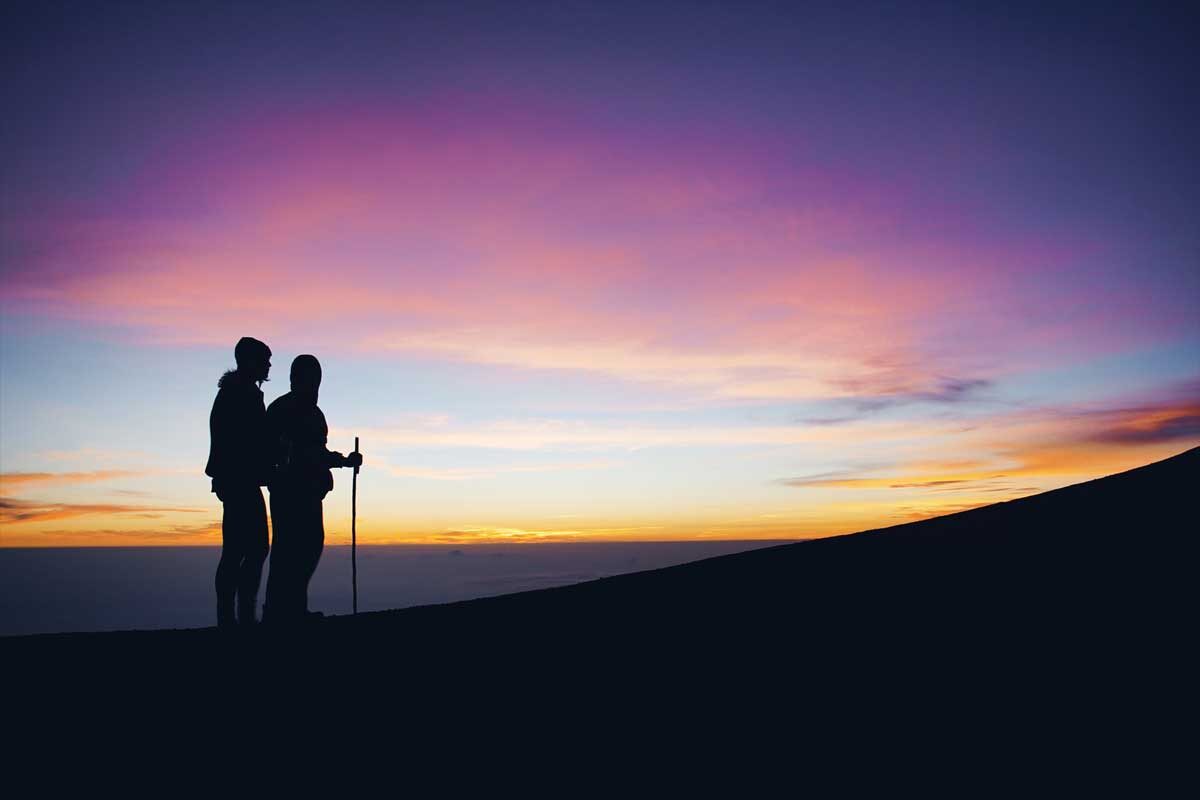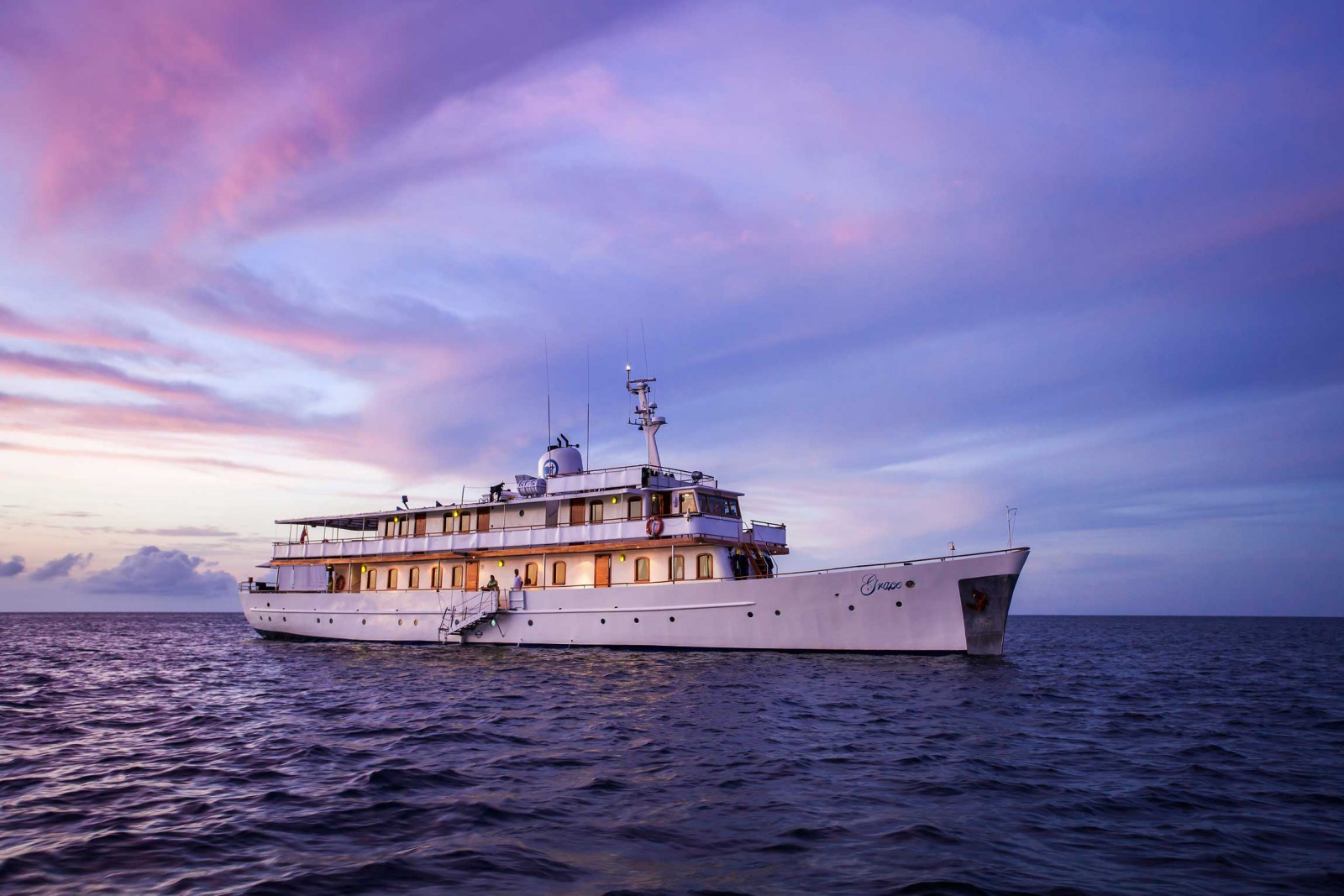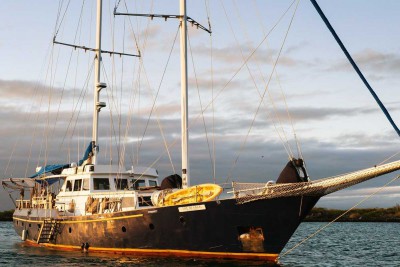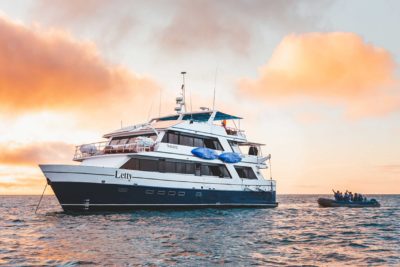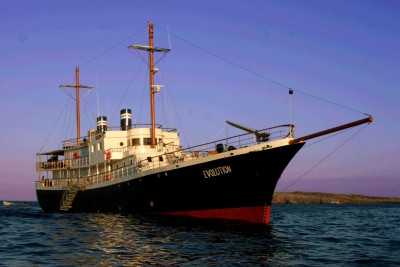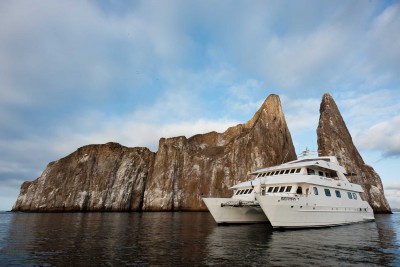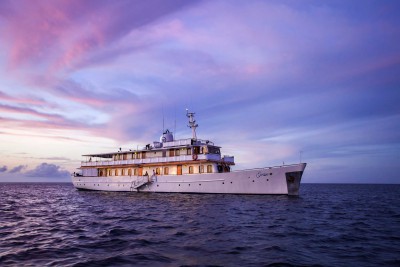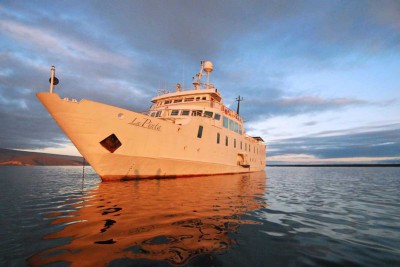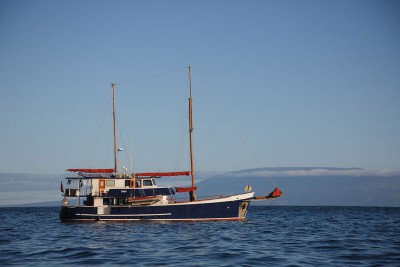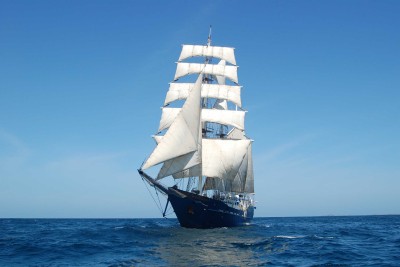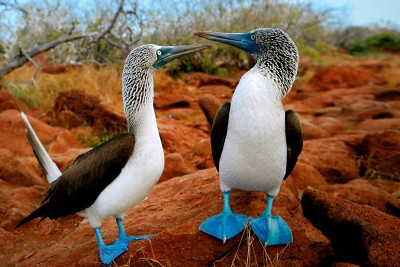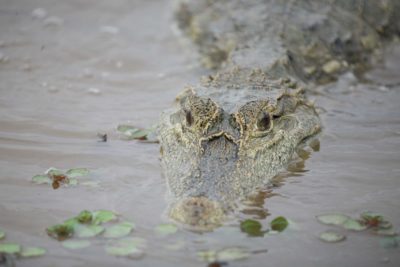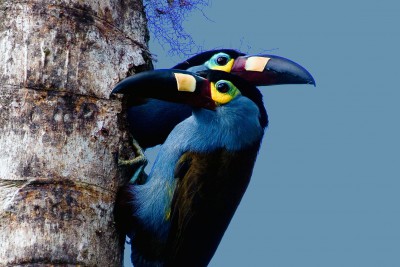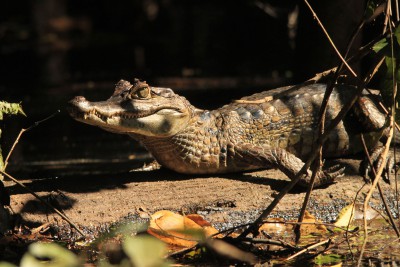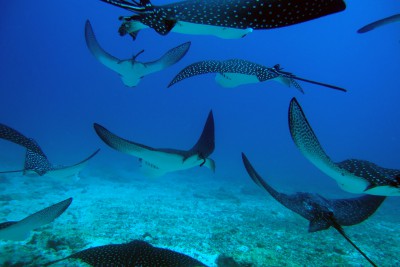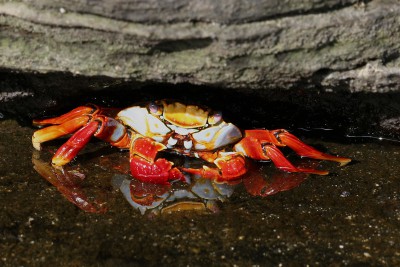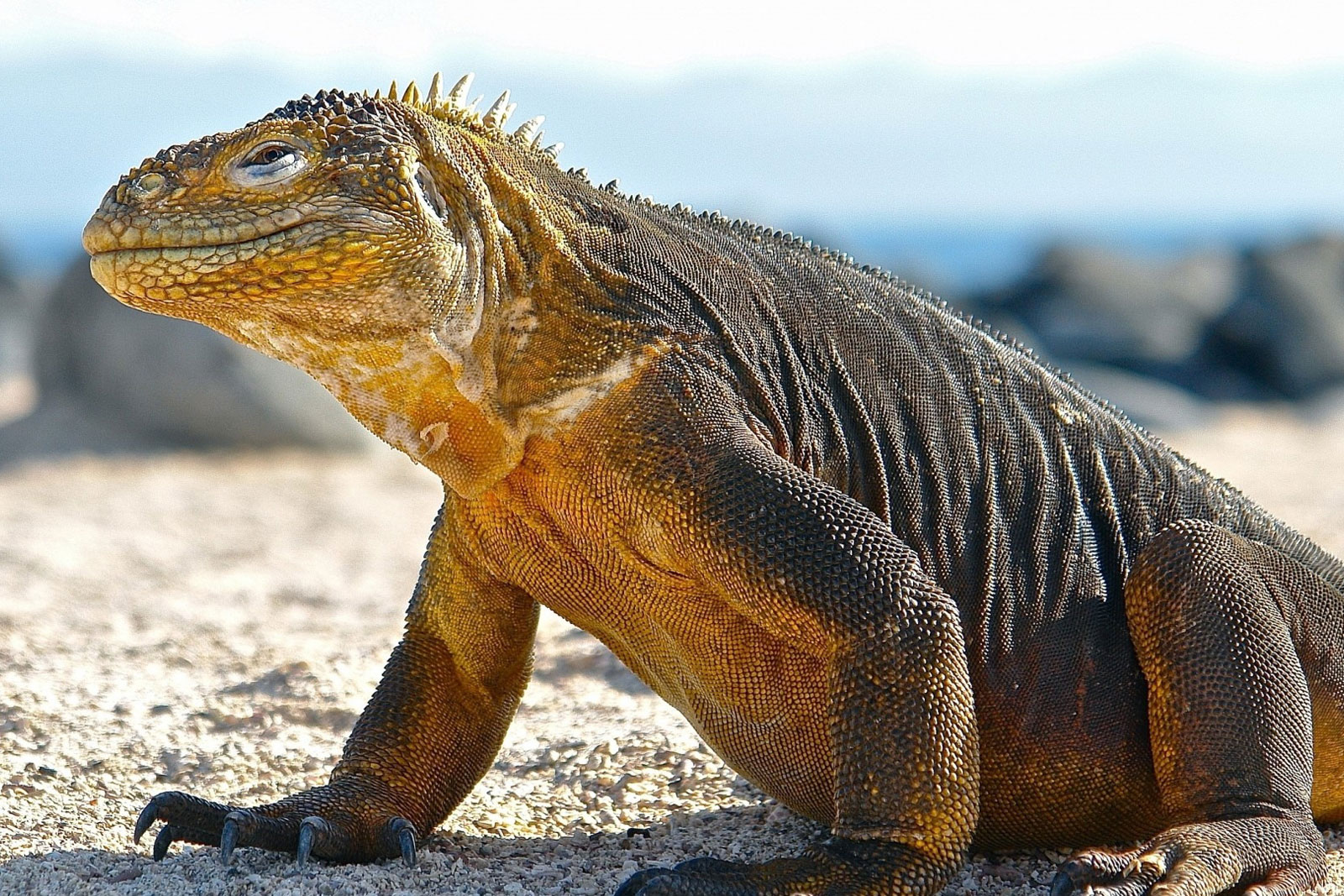
Galapagos Cruises
Tour Introduction
With dramatic volcanic landscapes and lying directly on the Equator, the geologically recent Galapagos Islands rate as one of the most unusual wildlife locations in the world. Above water there are plants and semi-tame animals whose geographical isolation and adaptation to the harsh conditions have led to the evolution of many unique natural histories, including marine iguanas, giant tortoises and the famous Darwin finches. Underwater, cool currents have introduced otherwise coldwater species to these tropical seas: penguins, orcas and fur seals happily rub along with parrot fish, turtles and manta rays.
Of the 29 species of land birds on the islands, 22 are endemic including 13 species of Darwin’s finches. Nineteen species of seabird include waved albatross, flightless cormorant, Galapagos penguin, two species of frigatebird and three species of booby.
Mammals include the Galapagos sea lion, fur seal and cetaceans such as sperm, humpback and pilot whales, dolphins and orca. Ray and shark species include the Galapagos shark, scalloped hammerhead and whale shark.
Among the resident reptiles are a large nesting population of the Pacific green turtle, two species of land iguana, marine iguana, seven species of lava lizard, nine species of gecko (of which five are endemic) and three endemic snakes. Noteworthy is the giant tortoise (Geochelone elephantopus), now sadly restricted to a mere handful of sites around the islands and most likely seen in the Centro de Crianza Fausto Llerena at the Charles Darwin Research Station on Santa Cruz Island, and other breeding centres.
There are in the region of 85 ships cruising the Galapagos Islands, ranging from 12 – 90+ passenger capacity. The best option to cover a wide variety of islands is a seven night cruise (or longer), though some ships offer shorter cruises as well.
For those wishing to sleep on dry land every night it is possible to have a land-based Galapagos program, staying in a hotel on Santa Cruz Island for a few days. These programs include day trips by boat to some of the nearby islands such as Bartolome, North Seymour and Santa Fe.
Some companies also offer ‘island hopping’ programs, visiting three or four islands (Santa Cruz, Isabela, San Cristobal and Floreana), staying in a comfortable hotel each night.
The Galapagos Islands are a year round destination, but there are some variations in weather and sea temperature throughout the year.
From about June until November it is the cooler, dry, foggy season in the Galapagos Islands, with average daily temperatures in the region of 26 degrees centigrade, and average water temperatures around 21 degrees centigrade. November is the transition month into the hotter, wetter season (most rain occurs in the higher elevations) with average day time temperatures up to 30 degrees centigrade in March and April, and an average water temperature of 25 degrees centigrade.
Underwater visibility is at its best in April and May, whilst the choppiest seas are in August and September.
Wildlife activity varies throughout the year, and there are some islands where specific species can be seen. For example, waved albatross can only be seen on Española Island between April and December, flightless cormorants can only be found on Isabela and Fernandina Islands, red-footed boobies on Genovesa Island (and a smaller colony on San Cristobal Island), and the majority of the population of Galapagos penguins are on Isabela and Fernandina Islands (though smaller populations can be seen on some of the other islands, such as Bartolome) as well.
We work with a variety of Galapagos ships, a selection of which can be seen here. Please contact us for further details about any of these, or any other, ships that are of interest, or a land-based or island-hopping program if preferred.
The sample itinerary below (from the Cachalote Explorer “Tower” itinerary) offers a glimpse of what you can experience on a wonderful Galapagos cruise.
Full Itinerary
On arrival on BALTRA ISLAND meet the guides and cross the Itabaca Channel on a 5-minute ferry ride to SANTA CRUZ ISLAND. Here a vehicle will be waiting to take you on a tour of the highlands.
Visit Los Gemelos (The Twins), two sinkholes surrounded by endemic scalesia forest where vermilion flycatchers, short-eared owls and finches can be seen. Continue to Rancho Manzanillo or one of the other private farms in the area to look for giant tortoises in the wild and have lunch. Then descend to the town of Puerto Ayora, watching as the scenery gradually changes as you wind your way down through all seven vegetation zones found in Galapagos.
Visit the Charles Darwin Research Centre on the edge of the town of Puerto Ayora, SANTA CRUZ ISLAND. See all three tortoise corrals and the breeding centre with new hatchlings and miniature tortoises not yet ready to be repatriated. Scientists from all over the globe work at the station and conduct biological research from anatomy to zoology. Stop at Van Straelen Hall where there are exhibits and a short video presentation. Visitors can see the tortoise and land iguana corrals. Puerto Ayora is the social heart of the islands with the largest population of 24,000 inhabitants. Time permitting there may be an opportunity to do some shopping, and for those desperate to re-connect with the outside world internet is available in the town. Board the Cachalote Explorer in the late afternoon.
Staying at Cachalote Explorer. Includes All Meals.
In the morning visit PLAZAS ISLANDS, two very small islands that were uplifted from the sea and separated by a channel. Only SOUTH PLAZAS ISLAND has a visitor site - the whole island is like a massive tilted plate with one side dipping into the water and the other raised into the air to form a cliff edge. It has tall, tree-like opuntia cactus and the ground is covered with sesuvium (a succulent plant). The main attractions here are land iguanas, sea lions including a bachelor colony, swallow tailed gulls, red-billed tropicbirds and Audubon’s shearwaters.
After lunch navigate to the small island of SANTA FE. The visitor site is located on the north-eastern side of the island and here there is a well-protected cove with a white sandy beach and shallow turquoise waters which makes a perfect location for snorkelling, swimming and kayaking. There are plenty of sea lions here which make the time in the water very interesting. On the small land trail, the main feature is the unique giant prickly pear cactus.
The land iguanas here are much lighter coloured than those elsewhere and are endemic to the island. You might see them feeding on fallen pads from the cacti. Galapagos mockingbird, magnificent frigatebird, brown pelican and several species of Darwin’s finch are common sights on the island.
Staying at Cachalote Explorer. Includes All Meals.
Today explore SAN CRISTOBAL ISLAND, the easternmost island of the Galapagos archipelago and one of the oldest. Visit Cerro Brujo (Witch’s Hill), a volcanic cone that overlooks a beautiful white sandy beach which has plenty of sea lions, pelicans, blue-footed boobies, waders and marine iguanas. Here there will be an opportunity to snorkel and kayak.
In the afternoon visit El Junco Lagoon. El Junco is the only large freshwater lake in the archipelago and here frigatebirds can be seen swooping to drink from the lake.
Staying at Cachalote Explorer. Includes All Meals.
Spend the day exploring ESPAÑOLA ISLAND. The long white coral beach at Gardner Bay is frequented by sea lions and the endemic long-billed (or Hood) mockingbird, and colourful lava lizards. Here there will be an opportunity to snorkel and kayak.
Punta Suarez is one of the most interesting visitor sites in all of the Galapagos. The landing point is covered with sea lions and their young, and thousands of marine iguanas bask on the rocks. The marine iguanas here are unique, displaying copper red patches and keeping some red all year around. This is the only island where you find waved albatross and there is a large breeding colony of them here during the mating season (April to December). The island has a large blowhole around which hundreds of marine iguanas congregate. There are blue-footed and masked boobies nesting here, oystercatchers and swallow-tailed gulls.
Staying at Cachalote Explorer. Includes All Meals.
Spend the day exploring FLOREANA ISLAND. Floreana has had a colourful history: Pirates, whalers, convicts, and a small band of somewhat peculiar colonists—a Baroness among them—who chose a Robinson Crusoe existence that ended in mystery and death. In the morning visit Punta Cormorant which offers two highly contrasting beaches; a green-olivine beach and an iron-red beach. Between the two beaches is a salt lagoon frequented by flamingoes, pintails, stilts and other wading birds. There will be an opportunity to snorkel here.
Enjoy snorkelling at Devil's Crown, which is home to a myriad of marine species including a variety of corals, pencil sea urchin, wrasses, angelfish and amberjacks - making for some of the best snorkelling in the Galapagos.
Finish at Post Office Bay, where in 1793 British whalers set up a barrel as the island‘s Post Office, to send letters home on passing ships. The tradition continues to this day, simply by dropping a post card into the barrel without a stamp. There will be an opportunity to snorkel here.
Staying at Cachalote Explorer. Includes All Meals.
Morning visit to Cerro Dragon, SANTA CRUZ ISLAND, named for the large number of land iguanas that frequent the area, and an important nesting site for iguanas reintroduced by the Charles Darwin Research Centre. A short walk from the beach leads to a hypersalinic lagoon that is frequented by pink flamingos, common stilts, pintail ducks and other species of birds. From here, pass through a forest of the endemic scalesia tree. There are only 400 specimens of the scalesia tree left in the world. Past the forest, hike up Dragon Hill for impressive views of the bay. There will be an opportunity to snorkel from the beach.
In the afternoon visit Sullivan Bay, SANTIAGO ISLAND, one of the most outstanding volcanic sites in the Galapagos. In the nearly 100 years since the Sullivan Bay lava flow, only a few plants such as mollugo and lava cacti have managed to take root in this harsh environment. Oystercatchers can be seen fishing for crabs and molluscs in the tide pools of Sullivan Bay. After exploring the lava flow, there is swimming and snorkelling with playful sea lions off two small coralline beaches.
Staying at Cachalote Explorer. Includes All Meals.
Spend the entire day on GENOVESA ISLAND, considered to be one of the most spectacular Islands in Galapagos for bird species.
In the morning have a dry landing at Prince Philip’s Steps. Red-footed boobies nest here in Palo Santo trees and Nazca (formerly masked) boobies nest near the trail. In an open lava field, you find storm petrels in large numbers. If you are lucky, you will see the elusive short-eared owl. Look for the beautiful red-billed tropicbird usually found in the crevices along the shoreline. There will be an opportunity for snorkelling.
In the afternoon have a wet landing on Darwin Bay, a coral sand beach where swallow-tailed and lava gulls gather near the tide pools. Enter a forest of opuntia cactus and mangroves where colonies of great frigate birds nest. The males inflate their red-throated pouches to attract females as they fly overhead. The trail leads through a rich inter tidal zone where you find a wide diversity of wildlife. After the walk, you can swim and snorkel from the beach with sea lions in these northern warmer waters.
Staying at Cachalote Explorer. Includes All Meals.
Visit Black Turtle Cove, SANTA CRUZ ISLAND. No landing is allowed, but during a dinghy ride in this sheltered lagoon young white-tipped reef sharks are often seen, as well as schools of spotted eagle rays or golden rays.
Then return to BALTRA in time for the flight back to the Ecuadorian mainland.
Includes Breakfast.
Tour Accommodation
Overview
The Beagle is a classic, teak decked schooner with ample deck space for relaxation and sunbathing. Her size makes for an intimate Galapagos experience. Awarded the Smart Voyager Certificate for adherence to sound conservation practises.
Swimming Pool
Air Conditioning
Capacity
Length
Class
Cabins
6 single upper/double lower and 1 single cabin
Facilities
Lounge,dining room,bar, al fresco dining and library.
Optional Activities
Snorkelling gear can be borrowed and the Beagle also has kayaks.
Overview
Beluga is a fast, comfortable motor yacht designed for an intimate and immersive Galápagos experience. With panoramic windows in the salon, guests can enjoy breathtaking views of the islands while relaxing in the spacious lounge. The yacht boasts ample deck space, perfect for soaking in the scenery or unwinding under the equatorial sun. Equipped with stabilisers for steadier cruising, Beluga ensures a smooth and enjoyable journey. Accommodating up to 16 passengers in eight well-appointed cabins, each with private bathrooms and air conditioning, the yacht offers both comfort and exclusivity. Awarded the Smart Voyager Certificate for its commitment to sustainable tourism, Beluga operates with environmentally responsible practices, allowing guests to explore the Galápagos with minimal impact.
Swimming Pool
Air Conditioning
Capacity
Length
Class
Cabins
2 double (1 with queen size), 4 twin and 2 single upper/double lower cabins
Facilities
Lounge/dining room with picture windows, bar, ample deck space for relaxation and sunbathing.
Local Wildlife
Birds: Galapagos penguin, magnificent frigatebird, blue-footed booby, waved albatross, lava gull, Galapagos hawk, flightless cormorant, red-footed booby, Galapagos mockingbird, Española mockingbird, medium ground finch, swallow-tailed gull, lava heron, Galapagos petrel, Galapagos dove, white-cheeked pintail, Galapagos crake, great blue heron, great frigatebird, Floreana mockingbird, band-rumped storm petrel, Markham's storm petrel, least sandpiper, large tree finch, large ground finch, sanderling, small ground finch, common cactus finch, woodpecker finch, small tree finch, Eurasian whimbrel, medium tree finch, Galapagos short-eared owl, smooth-billed ani, Española cactus finch, green warbler-finch, grey warbler-finch, yellow warbler, American flamingo, red-billed tropicbird, ruddy turnstone, dark-billed cuckoo, Franklin's gull, black-necked stilt, semipalmated sandpiper, short-billed dowitcher.
Marine mammals: Galapagos sea lion, Galapagos fur seal, Bryde's whale, humpback whale, sperm whale, orca, false killer whale, pilot whale, common dolphin, bottlenose dolphin.
Land mammals: Galapagos bat, hoary bat, Galapagos rice rat.
Reptiles: Giant tortoise, lava lizards, Galapagos marine iguana, Galapagos land iguana, Barrington land iguana, Galapagos racer snakes, yellowbelly sea snake, green turtle, olive Ridley turtle, leatherback turtle, hawksbill turtle.
Overview
Originally a fishing boat built in 1988 in Vancouver, Canada, this spacious motor vessel was converted into a passenger ship in the early 2000’s. There are 8 ensuite cabins each with hot water, air-conditioning throughout, a large salon/dining area with flat screen TV and DVD player, sun deck, and other ample deck areas for relaxing. Cachalote Explorer also carries two kayaks for guest use.
Swimming Pool
Air Conditioning
Capacity
Length
Class
Cabins
1 Upper Deck cabin with a lower queen bed, lower single bed and single upper bed, 1 Upper Deck cabin with a lower double and upper single bed, 3 Lower Deck cabins with a double lower and upper single bed, 2 Lower Deck cabins with a lower queen bed, and one Lower Deck cabin with a lower single and a small upper single.
Facilities
Large lounge and dining area with flat screen TV and DVD, air conditioning, sun deck and other ample deck areas.
Local Wildlife
Birds: Galapagos penguin, magnificent frigatebird, blue-footed booby, waved albatross, lava gull, Galapagos hawk, flightless cormorant, red-footed booby, Galapagos mockingbird, Española mockingbird, medium ground finch, swallow-tailed gull, lava heron, Galapagos petrel, Galapagos dove, white-cheeked pintail, Galapagos crake, great blue heron, great frigatebird, Floreana mockingbird, band-rumped storm petrel, Markham's storm petrel, least sandpiper, large tree finch, large ground finch, sanderling, small ground finch, common cactus finch, woodpecker finch, small tree finch, Eurasian whimbrel, medium tree finch, Galapagos short-eared owl, smooth-billed ani, Española cactus finch, green warbler-finch, grey warbler-finch, yellow warbler, American flamingo, red-billed tropicbird, ruddy turnstone, dark-billed cuckoo, Franklin's gull, black-necked stilt, semipalmated sandpiper, short-billed dowitcher.
Marine mammals: Galapagos sea lion, Galapagos fur seal, Bryde's whale, humpback whale, sperm whale, orca, false killer whale, pilot whale, common dolphin, bottlenose dolphin.
Land mammals: Galapagos bat, hoary bat, Galapagos rice rat.
Reptiles: Giant tortoise, lava lizards, Galapagos marine iguana, Galapagos land iguana, Barrington land iguana, Galapagos racer snakes, yellowbelly sea snake, green turtle, olive Ridley turtle, leatherback turtle, hawksbill turtle.
Overview
The ship has a capacity for 20 passengers, with 4 cabins with picture windows on the Dolphin (upper) Deck, 2 cabins with pictures windows on the Booby (main) Deck, and 4 cabins with port holes on the Iguana (lower) Deck. All cabins are fully air-conditioned. There is also a Booby Deck bar, dining room and lounge with TV for presentations, and a partially covered Sun Deck. Kayaks and paddle boards are available for guests to use.
There are two naturalist guides on board (if there are 16+ passengers) providing one of the best guide to guest ratios in the Galapagos Islands. Letty was one of the first carbon neutral ships in the Galapagos Islands, and was awarded the Smart Voyager Certificate for adherence to sound conservation practises.
Swimming Pool
Air Conditioning
Capacity
Length
Class
Cabins
8 double/twin and 2 triple cabins
Facilities
Lounge/dining room/bar, sun deck, kayaks
Overview
Evolution is a modern expedition cruise shop built in a classic 1920s style. It is large enough to provide stability whilst cruising, but still maintains a cosy atmosphere.
Swimming Pool
Air Conditioning
Capacity
Length
Class
Cabins
16 double/twin convertible cabins
Facilities
Lounge/bar, library, inside and al fresco dining areas, sun deck, hot tub and infirmary.
Overview
The Galapagos Seaman Journey is one of the most comfortable catamarans cruising the Galapagos Islands. The dual hull design enables a smoother ride, with increased stability and additional deck space not usually found on similar-sized single hull vessels.
Swimming Pool
Air Conditioning
Capacity
Length
Class
Cabins
6 cabins with 2 single lower berths on main deck and 2 double cabins on upper deck
Facilities
Lounge,bar, small TV room and mini library and sundeck.
Optional Activities
Activities include hiking, kayaking, zodiac rides, swimming, snorkelling and general exploration.
Overview
The Grace was once owned by Aristotle Onassis, Prince Rainier and Princess Grace of Monaco, and even had a stint in the Royal Navy! Today she is the most luxurious of the small motor yachts cruising the Galapagos Islands, and with 2 naturalist guides for just 16 guests has one of the best guide to guest ratios in the Islands.
Swimming Pool
Air Conditioning
Capacity
Length
Class
Cabins
9
Facilities
Lounge/bar, inside and al fresco dining, sun deck, library, Jacuzzi, 6 kayaks and 2 zodiac dinghies.
Overview
La Pinta offers a relaxed yet luxurious expedition atmosphere with state of the art interpretation facilities. Interconnecting cabins and a ‘Young Pirates’ program make this ship an excellent option for families.
Swimming Pool
Air Conditioning
Capacity
Length
Class
Cabins
24 outside cabins with twin or queen size beds including 6 interconnecting cabins for families
Facilities
Conference room, satellite internet, bar/salon, dining room, sky bar and sundeck, gym, jacuzzi, glass bottom boat, kayaks, infirmary.
Overview
Samba is a Dutch built steel-hulled motor yacht. Comfortable and well laid out she offers simple accommodations at a good price.
Swimming Pool
Air Conditioning
Capacity
Length
Class
Cabins
6 single upper/double lower and 1 double cabin
Facilities
Lounge/dining room/bar, al fresco dining, observation deck/sun deck, TV and VCR room, and a mini library of books and videos.
Overview
Built for 32 passengers, the Mary Anne operates with only 16 guests providing ample space both in the cabins and the communal areas. She has over 1,000 square metres of sail allowing guests to fully appreciate the romance of sail. The sails will be hoisted for part of the cruise if conditions permit. Awarded the Smart Voyager Certificate for adherence to sound conservation practises.
Swimming Pool
Air Conditioning
Capacity
Length
Class
Cabins
2 single cabins, 6 double cabins with single upper/double lower berths and 2 twin cabins (1 single & 1 double)
Facilities
Lounge,bar, dining room, library, ample sun decks, kayaks.
Route Map
Departure Dates
Travel Information
Are International Flights Included?
No. Please contact us for a quote if required.
Flight Info:
There are direct flights from Quito and Guayaquil to both Baltra and San Cristobal in the Galapagos Islands though most ship operators use the route Quito - Guayaquil - Galapagos.
Best Visited:
January to January
Are you ATOL Registered?
Yes. This means we are legally able to book your international flights in conjunction with your ground arrangements so you can book with us with complete confidence. Read more about our ATOL license here.

John Melton
Area Specialist
If you have any questions regarding this Tour, please feel free to contact me on +44 (0)1803 866965
We saw far more than we dreamt of. It was like being in a zoo without bars! Your agent…was always available to answer our questions and his knowledge was invaluable.
